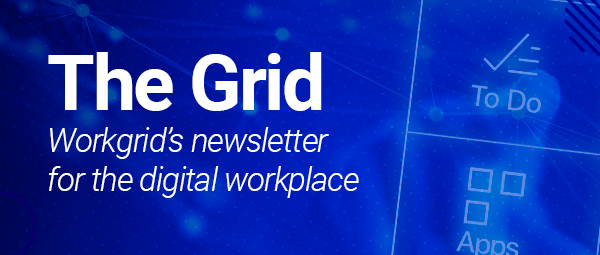Our reliance on systems and technology to get work done has, in many ways, made us more powerful. It has also made us less efficient. Reporting from Harvard Business Review shows that on average, employees use 22 different applications and web properties per day. This may not seem like a large number, but the more systems that require attention, the more context switching that is required throughout the day.
It is not to say that we as humans cannot do two things at once. Many could argue that we are now so used to digital noise that it could not possibly impact our work. But that would be naïve. In fact, studies have shown that the average person takes 23 minutes to re-focus after shifting from one task to another.
Creating a centralized delivery of integrations
This loss of focus and attention due to technology at work is not the end of the road. Resolving friction starts with the centralization of technology through the use of integrations. Surfacing the data, notifications, information, and resources employees need within one unified stream is the first step in simplifying the digital landscape and making it more intuitive for employees.
Integration use cases have evolved as a result of increasing adoption of software and the need to connect experiences and data across a distributed workforce. In this context, integrations have become far more than just a technical detail but rather a business necessity for employees and customers alike.
Leveling up the integration experience
While centralizing integrations in one place – like the company intranet or collaboration and communication tools like Microsoft Teams – is a huge step in reducing digital distractions, it only just skims the surface of what’s possible within the digital workplace. Organizations should strive to take this technology one step further by guiding employees’ attention to what they need to know and do, when they need to know and do it.
Leveraging AI technology such as nudgetech or conversational AI to push and pull information from business systems gives employees not only a centralized experience to access integrations, but also a more intelligent experience as well.
Take for example time off. With conversational AI, an employee could simply ask “what is my time off balance?” and receive an instant reply of their current time off accrual without ever navigating away from the window. To take it one step further, perhaps an employee hasn’t taken time off in quite a while. An integration leveraging nudgetech may be able to deliver an alert encouraging the employee to use their time off benefits and recommend some open time in their calendar.
While both examples surround time off, the idea is that integrations become increasingly more powerful when they are used in the context of an AI experience – both providing employees with information they may be searching for, but also information they may not have yet considered themselves.
Taking an employee-centric approach
It’s important to consider the role vendors play in the integration story. Many offer integrated experiences, but they are most often centralized to the vendor's specific platform. In theory, these are good ideas, but consider the experience of the employee. Many platform-centric integrations will not encompass all the employee personas within an organization. For example, the average non-IT employee doesn’t spend all day in ServiceNow, so although it might be convenient for an IT person to see their tickets and workload, while also seeing HR information, other teams don’t want to spend time in ServiceNow.
When thinking about an integration strategy you should think carefully about creating an experience that makes sense in the context of how employees work. Integrations should not create yet another thing to check, and therefore are best delivered to employees within the flow of work. Surfacing integrations in places like the company intranet, Microsoft Teams, and other workstream collaboration channels are great options to limit distraction and provide value to employees throughout the work day.
![[gif] Expense Approval Teams Animation 1920x1080](http://images.ctfassets.net/z7p73u8c0thn/1z2MhWMsWooINCBQAQIh8S/3af5b985c04a5c2c729a04e5418c2b5f/Approval_2.gif)
Implementing integration projects
Before beginning an integration project, there are a few questions to consider.
What is the objective of the integration?
Who owns and defines how the integrations should be used?
Who is responsible for the delivery of integrations?
For many organizations the answers to the above questions are vastly different across departments and roles. Take a payroll system for example, this is often defined and owned by an accounting or finance department. However, it may be human resources who are looking to integrate the system into the company intranet to better deliver the information to employees. Yet, it is the IT team who is ultimately responsible for the delivery of the integration itself.
While working cross-department is not a bad thing, it does create some additional friction and hurdles when it comes to managing integrations within the digital workplace. Teams work at different speeds, have competing priorities, and often different ideas of why a system is needed in the first place, which is why it is critical to address these questions at the very beginning of defining an integration strategy.
An integrated digital workplace in which systems work with and speak to each other may seem like an obvious solution to end digital friction at work, but there are several other hurdles organizations need to overcome just to get integrations in place. Regardless of company size, from small business to enterprise, there are limited resources available to implement, operate, and monitor technology at work. Integrations can be complicated and time-consuming. While application owners may see value in integrating systems, they have other responsibilities to attend to which makes lengthy integration projects a nice to have, not a necessity.
So, how do digital workplace leaders overcome this type of challenge? The first step is to find a scalable method of building integrations, which can include templates, low-code/no-code builders, or third-party contractors. While the latter would likely be the most hands-off approach, many application owners would prefer to build experiences themselves. This is where a low-code/no-code builder comes into play. This type of system can accelerate the time to build integrations with prefab templates and drag-and-drop functionality. Owners can more easily build and deploy apps without complexity using triggers, actions, loops, and real-time testing, removing the reliance on IT teams and reducing build time from weeks to hours.
The constantly evolving digital landscape
A continually evolving digital landscape means regularly ushering in new tech. It also means systems and use cases can quickly become outdated or obsolete. A well-defined integration strategy prepares for the ever-changing technology landscape by focusing on driving adoption of existing tools.
Integrating legacy systems into your digital workplace hub can transform manual processes and outdated interfaces into the modern and intuitive experiences employees expect. With the help of AI, these experiences can become even more intelligent. For example, consider a large enterprise that has been using the same onboarding system for many years. It’s old and cumbersome to navigate but it works. It would take a lot of time and money to invest in something new. Instead of transitioning to a new system, the application owner integrates with the organization’s digital assistant. Now, employees automatically receive the information they need to know based on their personal attributes. Furthermore, they can use natural language to ask questions, complete tasks, and locate information. While it may seem small to empower one employee to use conversational AI to ask, “where is the company handbook?” optimizing business processes long-term across thousands of employees and hundreds of systems are improvements to the employee experience that can have lasting effects.
![[asset] HR-Employee-Engagement-Use-Case](https://images.ctfassets.net/z7p73u8c0thn/4Asy23vgB40IxDYBtOvt3L/1c7ed19bf6d95c425f5c1bbe16d572f3/HR-Employee-Engagement-Use-Case.png?w=1200&h=1200&q=60&fm=png&bg=transparent)
An integration strategy for the future of work
A well-defined integration strategy reduces digital friction, boosts productivity, and drives adoption of technology investments. By leveraging tools such as low-code builders and artificial intelligence, application and digital workplace leaders can take the most important elements of business systems and deliver them to employees in the channels and systems they work in.




